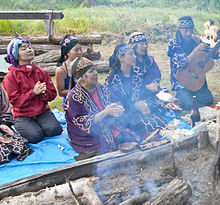
Back Ureuëng Ainu ACE Ainoe Afrikaans آينو Arabic آينو ARZ Ainu (etnia) AST Aynular Azerbaijani آینولار AZB Ainu BAR Айны Byelorussian Айны BE-X-OLD
アィヌ | |
|---|---|
 The Ainu flag designed by the late Ainu artist Bikki Sunazawa | |
 Ainu at a traditional wedding ceremony in Hokkaido | |
| Total population | |
| c. 25,000 | |
| Regions with significant populations | |
| 16,786 or more[1] | |
| 109[2][3]–1,000 |
| Languages | |
| Ainu language family (Hokkaido in Japan; historically prominent, now critically endangered); Japanese (Hokkaido dialects) or Russian (modern-day)[4] | |
| Religion | |
| Related ethnic groups | |
| Ainu | |
|---|---|
| People | Ainu |
| Language | Ainu languages |
| Country | Ainu Mosir |
The Ainu are an ethnic group comprising related Indigenous peoples who are native to northern Japan, including Hokkaido and Northeast Honshu, as well as the land surrounding the Sea of Okhotsk, such as Sakhalin, the Kuril Islands, the Kamchatka Peninsula, and the Khabarovsk Krai; they have occupied these areas known to them as "Ainu Mosir" (Ainu: アイヌモシㇼ, lit. 'the land of the Ainu'), since before the arrival of the modern Japanese and Russians.[5][6][5][7] These regions are often referred to as Ezochi (蝦夷地) and its inhabitants as Emishi (蝦夷) in historical Japanese texts.
Official estimates place the total Ainu population in Japan at 25,000. Unofficial estimates place the total population at 200,000 or higher, as the near-total assimilation of the Ainu into Japanese society has resulted in many individuals of Ainu descent having no knowledge of their ancestry.[8]
The Ainu are one of the few ethnic minorities in the Japanese islands, with a distinct and unique culture and way of life. They were subject to forced assimilation and colonization by the far larger Yamato population of Japan since at least the 18th century. Japanese assimilation policies in the 19th century around the Meiji Restoration included forcing Ainu peoples off their land; this, in turn, forced them to give up traditional ways of life such as subsistence hunting and fishing. Ainu people were not allowed to practice their religion, and they were pushed into Japanese-language schools where speaking the Ainu language was strictly forbidden. In 1966, there were about 300 native Ainu speakers; in 2008, there were about 100.[9][10] Since 2019, there have been increasing efforts to revitalize the Ainu language.[11]
- ^ "アイヌ生活実態調査". 北海道. Retrieved April 20, 2018.
- ^ a b "Results of the All-Russian Population Census of 2010 in relation to the demographic and socio-economic characteristics of individual nationalities". Federal State Statistics Service (in Russian). March 2019. Archived from the original on July 15, 2012. Retrieved January 28, 2013.
- ^ "2010 Census: Population by ethnicity". Federal State Statistics (in Russian). Archived from the original on April 24, 2012.
- ^ Gordon, Raymond G. Jr., ed. (2005). Ethnologue: Languages of the World (15th ed.). Dallas: SIL International. ISBN 978-1-55671-159-6. OCLC 224749653.
- ^ a b Cobb, Ellie (May 20, 2020). "Japan's forgotten indigenous people". BBC. Archived from the original on January 23, 2023.
- ^ Isabella, Jude (October 25, 2017). "The Untold Story of Japan's First People". SAPIENS. Archived from the original on January 23, 2023.
- ^ Shibatani (1990), p. 3.
- ^ Poisson (2002), p. 5.
- ^ Honna, Nobuyuki; Tajima, Hiroko Tina; Minamoto, Kunihiko (2000). "Japan". In Kam, Ho Wah; Wong, Ruth Y. L. (eds.). Language Policies and Language Education: The Impact in East Asian Countries in the Next Decade. Singapore: Times Academic Press. ISBN 978-9-81210-149-5.
- ^ Hohmann (2008).
- ^ "Linguistic Revival: How Japan Restored the Native Ainu Language with "AI Pirika"". stanfordrewired.com. Retrieved December 8, 2023.